Why this resume works
- Quantifies accomplishments: Measurable accomplishments, such as boosting graduation rates by 15%, highlight the applicant’s impact and value.
- Uses action-oriented language: Using powerful action verbs such as “implement,” “lead,” and “facilitate” conveys initiative and effectiveness.
- Illustrates problem-solving ability: Strategic planning to increase graduation rates demonstrates problem-solving skills and critical thinking.
More School Superintendent Resume Examples
Our school superintendent resume examples show how to showcase your leadership, educational expertise, and community engagement. Use these education resume samples to build a resume that highlights your skills and positions you as a strong applicant in educational administration roles.
Entry-Level School Superintendent
Why this resume works
- Effective use of keywords: Strategic keyword inclusion, such as “educational leadership” and “budget management,” aligns with role-specific terms to optimize ATS compatibility.
- Shows digital literacy: The resume emphasizes digital readiness through district-wide system implementation, showcasing computer skills relevant to modern workplaces.
- Centers on academic background: The education section highlights degrees in education and educational leadership, reinforcing qualifications for school leadership roles.
Mid-Level School Superintendent
Why this resume works
- Includes a mix of soft and hard skills: Balancing technical skills like curriculum development with interpersonal skills, the applicant fosters a collaborative environment and innovation in educational settings.
- Clear contact information: By crafting a professional resume header, the applicant ensures clarity and accessibility, paving the way for potential opportunities and callbacks.
- Displays technical expertise: Showcasing certifications such as Certified Superintendent, the applicant’s resume highlights essential technical expertise required to excel in educational leadership roles.
Experienced School Superintendent
Why this resume works
- Showcases impressive accomplishments: The applicant’s impressive accomplishments, such as increasing graduation rates and overseeing a $10M budget, reflect senior-level performance with significant business impact.
- Sections are well-organized: Well-organized sections using bullet points and headers make the resume easy to scan, highlighting key achievements like curriculum development and faculty retention improvements.
- Lists relevant certifications: Listing certifications like superintendent certification showcases the applicant’s expertise and commitment to continuous learning in educational leadership.
School Superintendent Resume Template (Text Version)
Jackson Highes
Hillcrest, NY 11507
(555)555-5555
Jackson.Highes@example.com
Professional Summary
Dynamic school superintendent with proven success in strategic planning and financial management. Expertise in curriculum development, community engagement, and staff performance improvement, driving measurable educational outcomes.
Work History
School Superintendent
Springfield Education District – Hillcrest, NY
July 2022 – July 2025
- Implement strategic plans boosting graduation rates 15%
- Lead budget allocation, improving financial outcome by 0K
- Facilitate training achieving 20% staff performance increase
Director of Education Programs
Midwest Learning Institute – Albany, NY
January 2019 – June 2022
- Develop curricula advancing state test scores by 12%
- Coordinate events enhancing community engagement by 30%
- Oversee E-learning adoption increasing student access by 50%
Principal
Riverbend High School – Buffalo, NY
February 2016 – December 2018
- Improved faculty morale reducing turnover by 8%
- Expanded extracurriculars boosting student participation by 25%
- Implemented STEM initiatives growing enrollment by 10%
Languages
- Spanish – Beginner (A1)
- French – Beginner (A1)
- German – Beginner (A1)
Skills
- Strategic Planning
- Budget Management
- Curriculum Development
- Community Engagement
- Staff Training & Development
- E-learning Initiatives
- Program Coordination
- Performance Improvement
Certifications
- Certified School Superintendent – National School Boards Association
- Educational Leadership Certification – Illinois Department of Education
Education
Master of Education Educational Leadership
University of Illinois Champaign, Illinois
May 2016
Bachelor of Arts Education
Illinois State University Normal, Illinois
May 2014
Related Resume Guides
Advice for Writing Your School Superintendent Resume
Explore our advice on how to write a resume for a school superintendent position. Whether you’re looking to highlight your leadership skills or showcase your dedication to educational excellence, we’ve got tailored tips just for you.

Highlight relevant certifications and training
Certifications and specialized training equip school superintendents with the knowledge and skills needed to lead educational systems effectively. These credentials reflect a commitment to continuous professional development and help establish credibility with staff, families, and community stakeholders.
Certifications in areas such as educational leadership, special education, or instructional technology highlight your ability to oversee diverse programs and support a broad range of student needs. Here are a few examples of certifications for our resume:
- Superintendent Certification or Endorsement
- Certified School Administrator (CSA)
- Chartered School Executive (CSE)
- Leadership in Education Administration Program (LEAP)
- School Finance and Budgeting Certification
- Equity-Centered Leadership Certification
- Crisis Management in Schools Certificate
- Education Policy and Leadership Certificate
Including certifications on your resume reinforces your readiness for the multifaceted responsibilities of a superintendent role. Position this section after your education or skills so it’s easy to find, and be sure to tailor it to the specific priorities of the district to strengthen your candidacy.
Example of a certifications & training section
School Superintendent Certification
Issued by: National Association of School Superintendents (NASS)
Issued 2021
Educational Leadership Development Program
Issued by: Harvard Graduate School of Education
Completed 2023
Advanced School Finance and Budgeting Workshop
Issued by: American Association of School Administrators (AASA)
Completed 2022
Crisis Management in Education Certificate
Issued by: University of Southern California Rossier School of Education
Expires 2024
Strategic Planning in K-12 Education Course
Issued by: Stanford Graduate School of Education
Completed 2023
Looking at professional resume examples can help you see what works well, making it easier to create your own standout resume.
List your most relevant skills
For a school superintendent role, showcasing a well-rounded mix of technical and soft skills is essential. Technical skills may include proficiency with budgeting software, scheduling tools, data analysis platforms, and learning management systems, all of which support effective and efficient district operations.
Equally critical are soft skills such as communication, leadership, and problem-solving. These abilities help superintendents collaborate with educators, engage with parents and community members, and respond swiftly to challenges. Adaptability and the ability to lead under pressure are also key traits for navigating the evolving landscape of education.
Your resume should feature a dedicated skills section that highlights both technical proficiencies, such as Excel, PowerSchool, or Google Workspace, and interpersonal strengths like strategic planning, conflict resolution, and public speaking.
To reinforce these skills, integrate them into your work experience bullet points. For example, rather than simply stating “oversaw district operations,” say “leveraged budgeting software to improve financial planning and used clear communication to resolve parent-teacher concerns.” This approach not only lists your skills but also shows how you’ve applied them to drive meaningful results.
A resume format that highlights leadership in educational programs, policy implementation, and community engagement can help school superintendents stand out.
Write a strong professional summary
A professional summary is the first impression you make on a hiring manager. It introduces your experience, skills, and achievements. When writing a resume, you can choose between a professional summary and a resume objective depending on your experience level.
A professional summary is typically three to four sentences that show your experience, skills, and accomplishments. It’s best for those who have substantial work experience because it highlights your professional identity and the value you bring to the role.
On the other hand, resume objectives focus on career goals. They are ideal for entry-level candidates, those changing careers, or people with employment gaps. While summaries say “what I’ve accomplished,” objectives talk about “what I aim to contribute.” We’ll provide examples of both summaries and objectives tailored to different industries and levels of experience.
School superintendent resume summary examples
Entry-level
Recent graduate with a master’s degree in educational leadership and a valid school superintendent certification. Experienced in student teaching and administrative internships, focusing on curriculum development and community engagement. Eager to contribute innovative ideas to improve student achievement and support teachers in fostering an inclusive learning environment.
Mid-career
Proactive school superintendent with over eight years of experience in managing K-12 educational systems. Proven track record of increasing academic performance through strategic planning and resource allocation. Skilled at leading teams, implementing effective policies, and strengthening stakeholder relationships to improve district-wide operations. Holds an advanced certificate in educational administration.
Experienced
Visionary school superintendent with more than 15 years of expertise in transforming underperforming schools into high-achieving institutions. Known for exceptional leadership skills, innovative program development, and data-driven decision-making that have consistently led to measurable improvements in student success rates across the district. Committed to fostering educational equity and building strong partnerships with community leaders.
School superintendent resume objective examples
Entry-level
Dedicated and knowledgeable education graduate aiming to launch a career as a school superintendent. Committed to fostering educational excellence and equity through innovative strategies and collaborative leadership within diverse school communities.
Career changer
Experienced business manager transitioning into the education sector, eager to leverage strategic planning and organizational skills as a school superintendent. Focused on improving student outcomes by implementing effective policies and building strong partnerships with educators and community stakeholders.
Recent graduate
Passionate recent graduate with a master’s degree in educational administration seeking an entry-level school superintendent role. Driven to support academic success by integrating evidence-based practices, promoting inclusive learning environments, and engaging with all members of the school community.
Try our Resume Builder to make a standout resume quickly and easily. It offers templates that help you highlight your skills and achievements as a school superintendent.
Showcase your accomplishments and publications
Listing publications and conference presentations on your resume can show your expertise and dedication as a school superintendent. It highlights your ability to contribute to educational research and share knowledge with others in the field.
By including peer-reviewed articles, book chapters, and conference papers, you show that you are actively engaged with current educational trends and challenges. Use a structured format to list these achievements, following professional style guides like APA or MLA for citation details such as journal name, volume, issue, and year.
Adding awards, grants, and fellowships that support your research boosts the credibility of your work. These accomplishments demonstrate not only your ability to conduct meaningful research but also that others acknowledge its value. Mentioning major awards can further highlight your leadership skills in the education sector.
Providing links to online profiles like Google Scholar or ResearchGate allows employers to easily access more of your work if they are interested. This approach paints a comprehensive picture of your commitment to advancing education through research and collaboration while showing how you stand out in the role of school superintendent.
Example of publications section
Publications & Presentations
- Robinson, M. (2024). Leading Through Equity: Transforming School Districts to Close Achievement Gaps. Educational Leadership Quarterly, 31(2), 78–94.
- Robinson, M. (2023, October). Strategic Budgeting for Student Success in Under-Resourced Districts. Presentation at the National Conference on School Finance and Equity, Atlanta, GA.
- Robinson, M. (2022). Chapter 6: Data-Informed Leadership in K–12 Systems, in L. Chen (Ed.), Innovations in Public School Administration (pp. 112–134). Education Insights Press.
- Grant Recipient – 2023 Excellence in Leadership Research Award, funded by the State Superintendent Association, for district-wide study on chronic absenteeism.
Pick a resume template that’s clean and straightforward. Use clear headings and easy-to-read fonts so hiring managers can easily spot your skills and experience.
FAQ
Do I need to include a cover letter with my school superintendent resume?
Including a cover letter with your school superintendent resume is recommended and can make your application stand out.
A cover letter lets you explain why you’re passionate about leading the district, highlight your leadership philosophy, and connect your experience to the school’s needs.
For example, if the district focuses on equity initiatives or improving student outcomes, emphasize relevant achievements or strategies you’ve implemented in similar roles.
You can also address any resume gaps with a cover letter and provide context for accomplishments not fully detailed there.
You can use our Cover Letter Generator for professional templates and content suggestions to help you create a standout cover letter. Explore our library of cover letter examples for additional inspiration to get started.
How long should a school superintendent’s resume be?
For a school superintendent, a two-page resume is typically appropriate. This lets you detail your extensive experience in educational leadership, policy implementation, and community engagement. Highlight significant achievements such as improved school performance metrics or successful program launches to demonstrate impact.
If you’ve held multiple superintendent roles or have notable accomplishments that require more space, extending to a third page is acceptable. Just ensure every entry is relevant and showcases your leadership abilities effectively.
Consider exploring our guide on how long a resume should be for examples and tips tailored to different career stages, including when to use a one-page resume.
How do you write a school superintendent resume with no experience?
If you’re aiming for a school superintendent role without direct experience, emphasize your educational background, leadership skills, and other relevant experiences. Here are a few tips on writing a resume with no experience to help you get started:
- Emphasize your education: Start with your highest degree in education or a related field. Include the name of the institution, graduation date, and any honors or distinctions received.
- Highlight leadership roles: If you’ve held positions such as principal, assistant principal, or department head, detail these roles. Emphasize responsibilities like managing staff, overseeing budgets, and implementing policies.
- Showcase relevant skills: Focus on skills important for a superintendent role, such as strategic planning, curriculum development, and community engagement. Provide specific examples where possible.
- Include professional development: List any certifications or training sessions you’ve completed that are relevant to educational leadership. This could include workshops on school administration or courses on educational policy.
- Volunteer work and extracurriculars: If you’ve been involved in committees or projects within the education sector outside of formal employment, include these experiences to show your dedication and initiative.
Tailoring your resume to highlight these areas can help demonstrate your readiness for a school superintendent role even without direct experience.
Rate this article
School Superintendent
Additional Resources
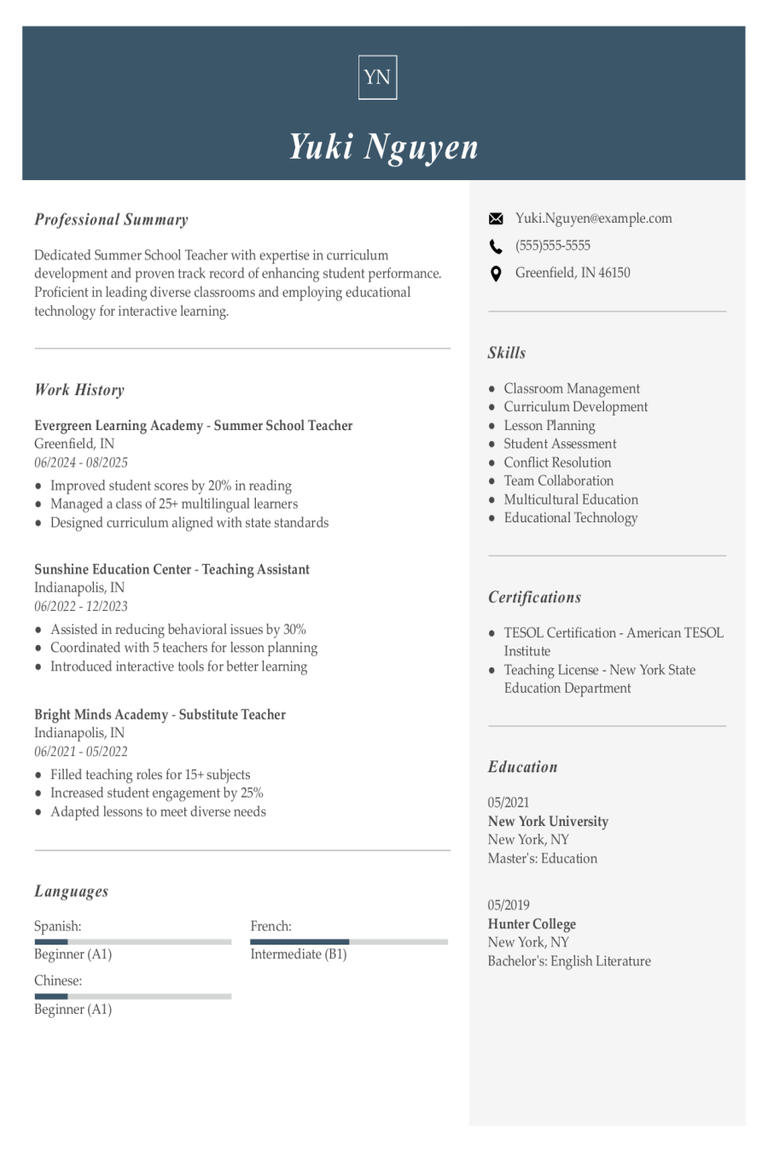
Summer School Teacher Resume Examples & Templates for 2025
Explore summer school teacher resume examples that focus on classroom management, lesson planning, and student engagement. Discover tips to show employers you’re creative, patient, and ready to inspire students.Build my
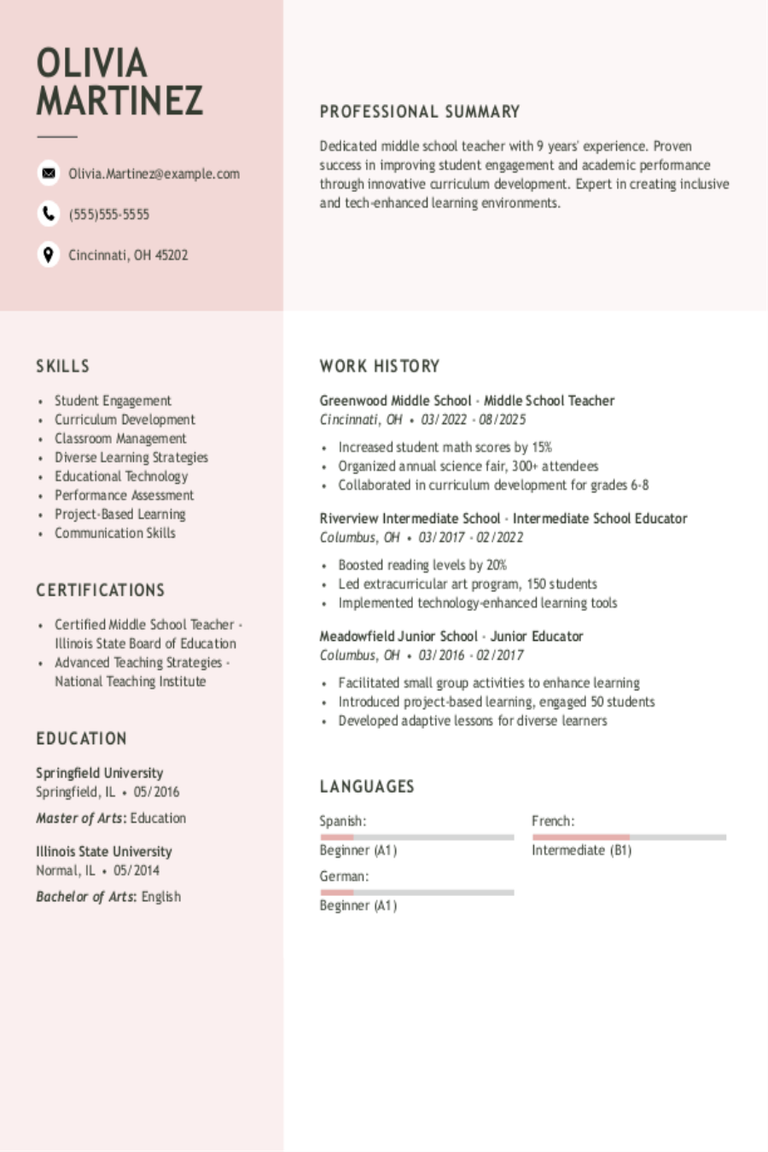
Middle School Teacher Resume Examples & Templates for 2025
Explore middle school teacher resume examples to see how to highlight your experience engaging young students, planning lessons, and managing classrooms. These examples and tips help you spotlight your teaching
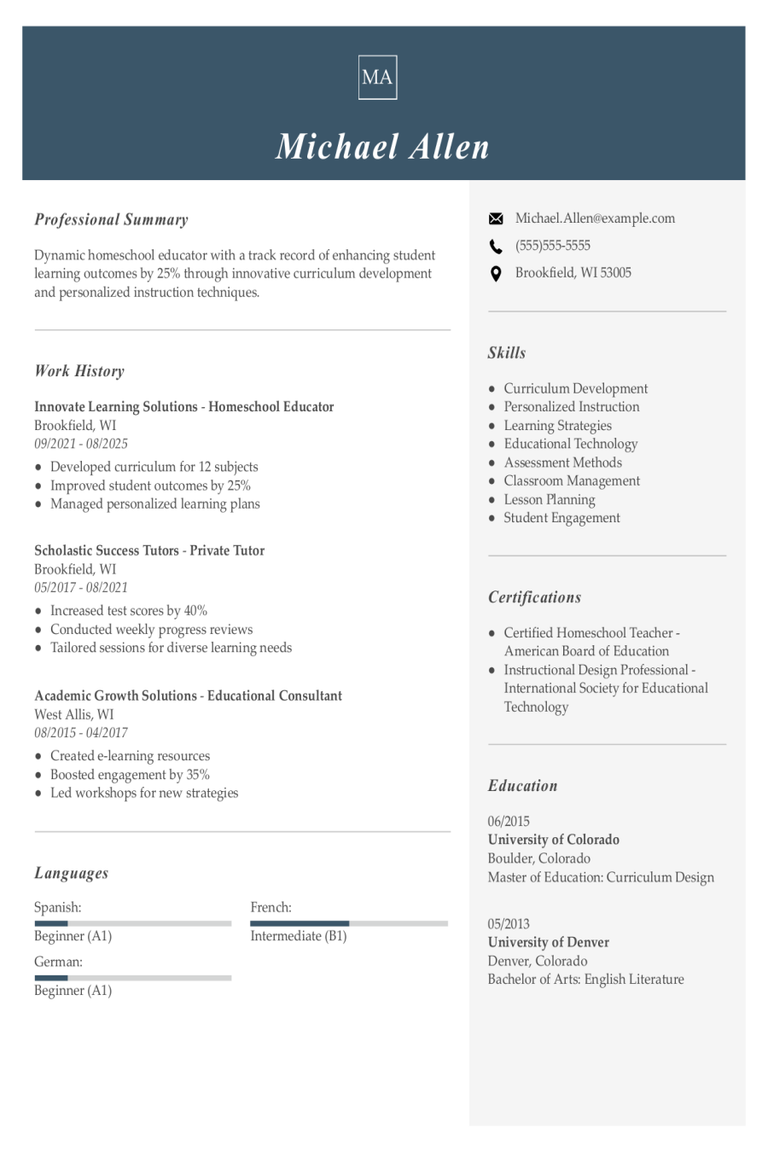
Homeschool Teacher Resume Examples & Templates for 2025
Looking to build a standout homeschool teacher resume? Our examples and tips will guide you in showcasing your teaching skills, curriculum planning, and ability to create engaging learning environments.Build my
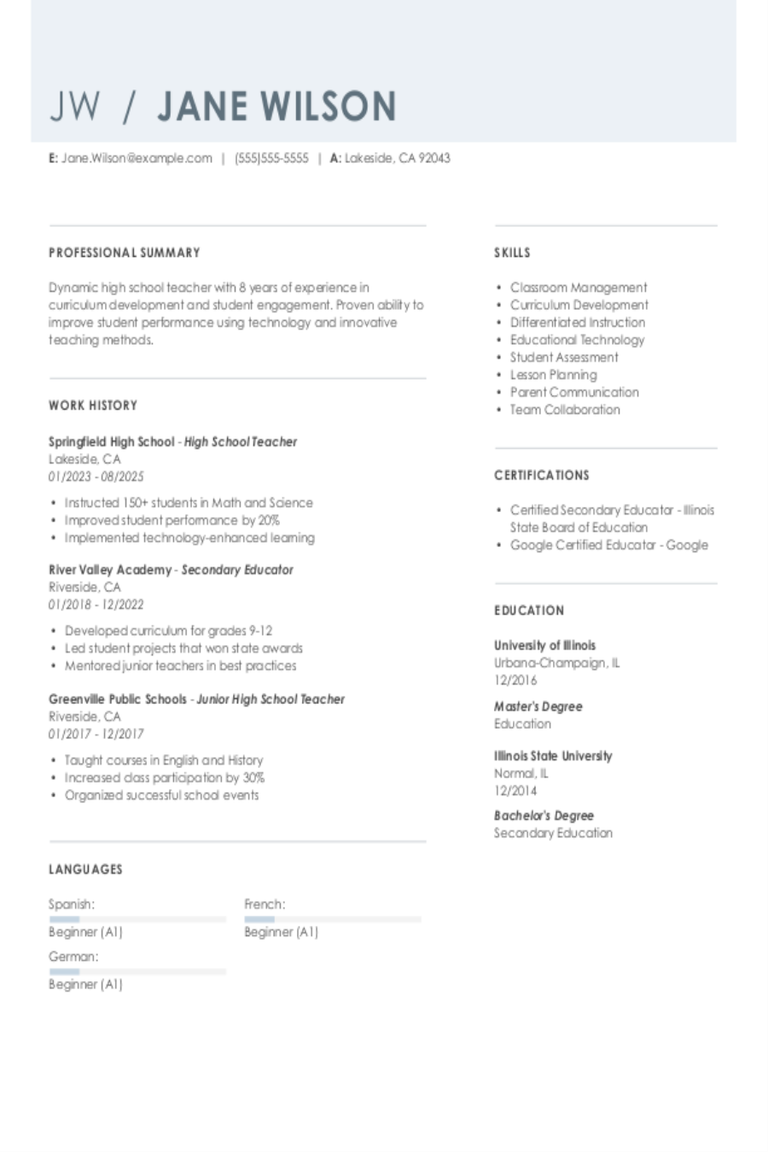
High School Teacher Resume Examples & Templates for 2025
Explore high school teacher resume examples that focus on engaging students and managing classroom activities. These tips will help you show off your teaching skills and highlight your relevant experience
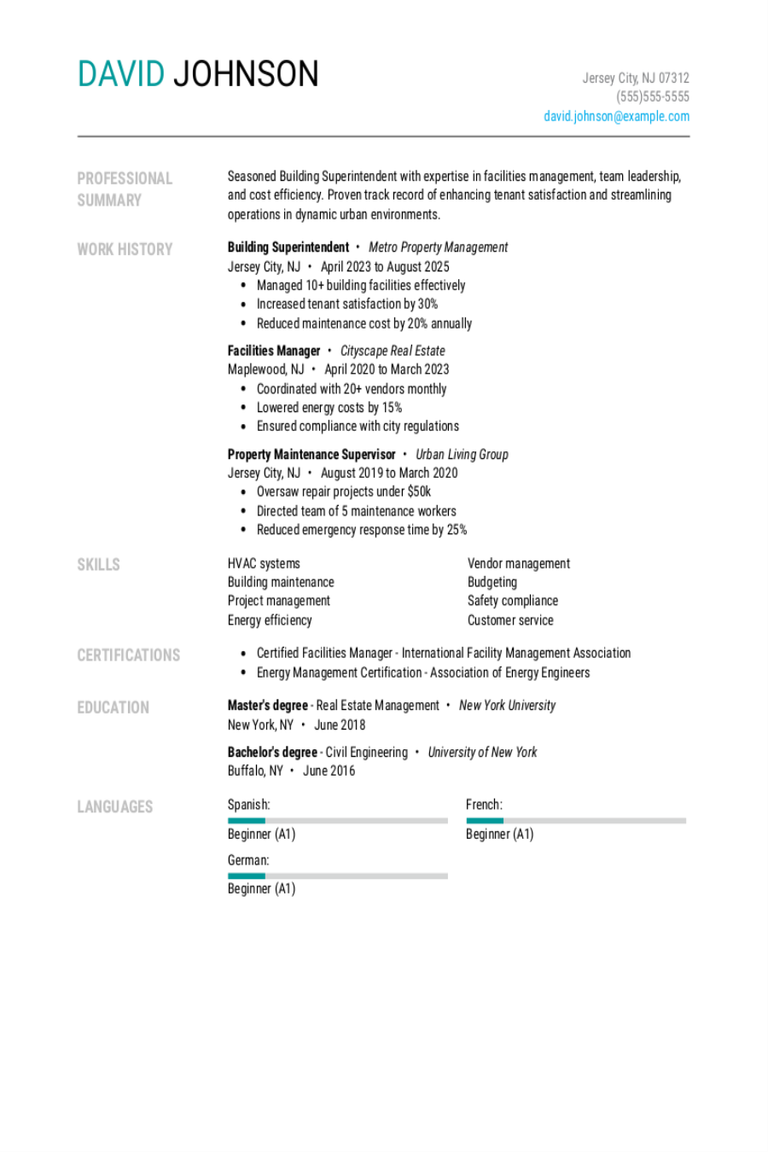
Building Superintendent Resume Examples & Templates for 2025
Browse building superintendent resume examples to see how to highlight your maintenance skills and experience managing properties. You’ll learn tips for showcasing your problem-solving abilities and effectively communicating with tenants.Build
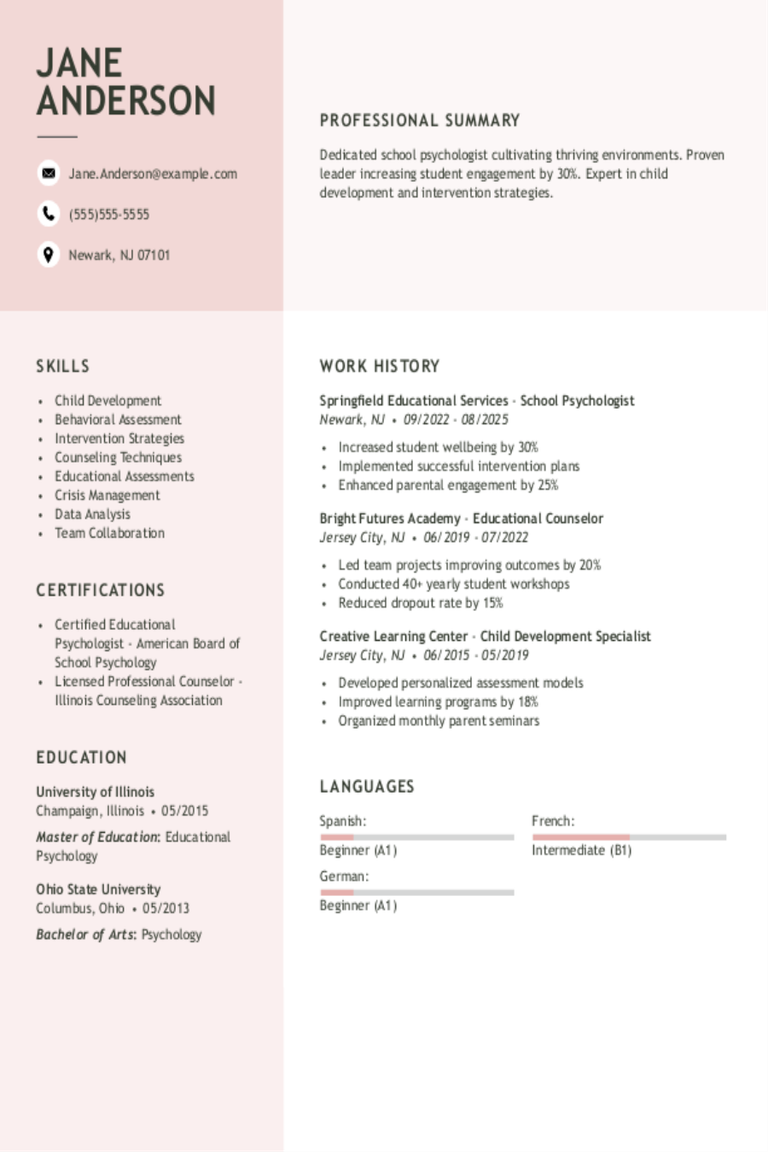
School Psychologist Resume Examples & Templates for 2025
Explore school psychologist resume examples and tips to learn how to showcase your skills in student assessment, counseling, and collaboration with teachers to stand out to hiring managers.Build my resumeImport
